Salem A. M. Bozrayd1, Ali M. Ksheish2, Tarek M. Shoeib3
1 Department of Zoology, Faculty of Science, University of Benghazi. Email: salem.bozrayda@uob.edu.ly
2 Department of forensic Sciences, Faculty of Biomedical Sciences, University of Benghazi. Email: ali.m.kshesh@gmail.com
3 Department of forensic Sciences, Faculty of Biomedical Sciences, University of Benghazi. Email: tarek.shoeib@uob.edu.ly
HNSJ, 2023, 4(7); https://doi.org/10.53796/hnsj4710
Published at 01/07/2023 Accepted at 20/06/2023
Abstract
The dermatoglyphic characters can measure genetics’ variations within and between human populations. This study aims to characterize the fingerprints traits in the eastern part of Libya, to analyze bilateral and bisexual differences within Libyan sub-populations. The study conducted on 1101 subjects in six cities; Benghazi, Al-Bayda, Al-Marj, Dernah, and Jalu-Ojla. Data included age, sex, and the parameters of digital dermatoglyphics have been recorded and analyzed. For statistical analysis, the frequency distributions for digital patterns were tested by chi-square, ridge were tested by student t test, and genetics distance were estimated by using the phylogenetic analysis. Total finger ridge count was significantly (p<0.01) higher in males (138.35) than females (131.46). D-indices were highest in Jalu-Ojla, Al-Bayda, Benghazi, Dernah and Al-Marj, respectively. F-indices were highest in Jalu-Ojla, Dernah, Benghazi Al-Bayda and Al-Marj, respectively; Total ridge counts were generally higher in males than females except in Jalu-Ojla and Al-Marj cities, where the latter two cities were equal. Arches and radial loops, ulnar loops were generally higher than the Whorls that were found in lower level due to the influence of consanguinity marriages, founder effect and random drift of genes. Total ridge counts were higher in males than females and in the right-hand, but not in left-hand for all the study areas. Therefore, the gender, bilateral side of the hand and the consanguinity level within the Libyan sub-population should be considered when establishing dermatoglyphic pattern indices for the Libyan population.
Key Words: Fingerprint patterns, human population Genetic, Libyan population
عنوان البحث
التباينات الجلدية الرقمية لدى سكان شرق ليبيا
HNSJ, 2023, 4(7); https://doi.org/10.53796/hnsj4710
تاريخ النشر: 01/07/2023م تاريخ القبول: 20/06/2023م
المستخلص
يمكن لسمات الجلدية بأصابع اليد أن تقيس الاختلافات الجينية بين افراد المجتمع، حيث تهدف هذه الدراسة إلى توصيف سمات بصمات الأصابع في الجزء الشرقي من ليبيا، لتحليل الفروق بين اليدين لدى الذكور والاناث داخل العشيرة الليبية بالمنطقة الشرقية. أجريت الدراسة على 1101 فردا في ستة مدن ليبية بالشرق: بنغازي، البيضاء، المرج، درنة، جالو وأوجله. حيث تم تسجيل وتحليل البيانات التي تضمنت العمر والجنس والمعايير الخاصة بالسمات الجلدية لبصمات أصابع اليد. إحصائيا، تم اختبار السمات النمطية لبصمات الأصابع (digital patterns) بواسطة مربع كاي، وتم اختبار نمط الانثناءات الجلدية للأصابع (finger ridges) باختبار (Student t test). كان العدد الإجمالي لانثناءات الأصابع أعلى معنويا (p <0.01) في الذكور (138.35) من الإناث (131.46). وكانت مؤشرات D (D-indices) هي الأعلى في مناطق جالو وأوجله والبيضاء وبنغازي ودرنة والمرج على التوالي. أما مؤشرات F (F-indices) هي الأعلى في جالو أوجلة ودرنة وبنغازي والبيضاء والمرج على التوالي. كان إجمالي عدد الانثناءات الجلدية أعلى بشكل عام في الذكور منه للإناث باستثناء مدن جالو وأوجله والمرج، حيث كانت المدن الأخيرة متشابهة. السمات النمطية لبصمات الأصابع: الأقواس (Arches) والحلقات الشعاعية (Radial loops) والحلقات الزندية (ulnar loops) تكرارها زائد بشكل عام في مناطق الدراسة، في حين أن نمط الدوامة (Whorls) وجدت بنسب منخفضة وذلك قد يرجع بسبب زواج الأقارب والتأثير المؤسس والانجراف العشوائي للجينات داخل العشيرة الليبية. بينما كان تعداد الانثناءات الكلية أعلى في الذكور منه في الإناث في اليد اليمنى، ولكن ليس في اليد اليسرى لجميع مناطق الدراسة. لذلك تنصح الدراسة الى مراعاة نوع الجنس وجانبي اليدين اليمنى واليسرى وكذلك مستوى القرابة عند وضع مؤشرات السمات الجلدية لبصمات الاصابع لدى العشيرة الليبية.
الكلمات المفتاحية: أنماط بصمات الأصابع ، الجينات البشرية ، السكان الليبيون
Dermatoglyphics Characteristics as a very important biometric tool has become one of the indicators to determine genetically related groups in multi-ethnic populations. Several studies have established variation in dermatoglyphics pattern among sub-populations. Dermatoglyphs are present on fingers, palms, toes and soles, giving insight into a critical period of embryogenesis, between 4 weeks and 5 months, when the architecture of the major organ systems is developing dermatoglyphics deals with the study of epidermal ridge configurations on palmar aspect of hand and planter aspect of sole, the dermal patterns do not change after birth, except that, they are modified by unequal growth of the hand, their form is determined by genetic and environmental uterine life.
They are not affected by environmental modification, the detailed structures of individual ridges are extremely variable, and dermatoglyphics traits can be used in both anthropological and clinical studies. Milicic (2002) analyzed dermatoglyphic traits provide an insight into the effect population structure and microevolution on quantitative variation (Milicić, 2002). Qualitative and quantitative dermatoglyphic traits were quite useful in tracing the historical background of the population (Crawford & Duggirala, 1992; Karmakar, Yakovenko, & Kobyliansky, 2002) also there were regarded as non-compatible with the interpretation of genetic structure (Siváková & Pospíšil, 2001). Mavalwala et al., (1977) reported that, the polygenic patterns of the finger type may reveal racial history more clearly than blood group (Mavalwala, 1977).
Variability in dermatoglyphics traits were found among sub-populations, despite the common origin Arrieta et al., (1990). Also, differences in digital and palmar traits were found even within the individual of tribe (Demarchi, Giordano, & Marcellino, 1997)
Libya characterized by small population (about 6.9 million) distributed over large area (1.76 million square KM) (Worldometer, 2020) . Also, the tribal system is very common and still exist especially in the eastern side of Libya. Some region dominated by just one or very limited tribes. No many dermatoglyphic studies were conducted for Libyan population in Benghazi (Ben Salah, 2001) and Falco, 1918, cited in (Naffah, 1974) in Tripoli, Benghazi is in the east of Libya (320 10, N200 06, E) and is considered as a second largest city in Libya, Benghazi has migrants from over all region of Libya and it might be considered as mixture of Libyan population, However, there are other Libyan regions in the east such as; Dernah, Al-Bayda, Al-Marj and Jalu-Ojla may represent a unique population structure differ from Benghazi, and they have very limited number of tribes, especially Jalu-Ojla which dominated by just two tribes (Al-Oajla and Al-Mjabra).
Subjects and Methods: This study conducted on six cities (N=1101); Benghazi, Al-Bayda, Al-Marj, Dernah and Jalu-Ojla (Figure 1). the samples represent 588 male and 544 female, their age ranged between 18 and 24 years. Data included the age, sex, and whether their parents are related or not.
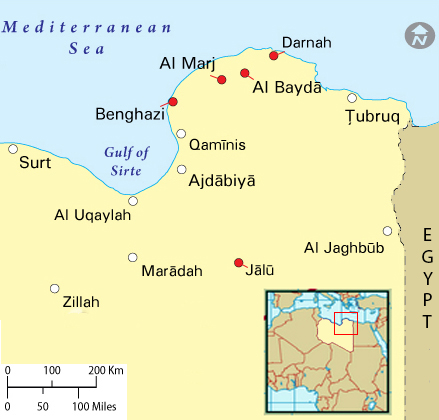
Figure (1): Location of the Libyan cities in this study.
The parameters of digital dermatoglyphics have been analyzed using the methods described by (Cummins & Midlo, 1961; Holt, 1968; Penrose, 1968; Plato, 1970; Plato, Brown, & Gajdusek, 1972). The fingerprints obtained were analyzed for various qualitative and quantitative characteristics.
Among the qualitative aspects, the frequency distribution of finger patterns including their digit-wise incidence, symmetrical occurrence of these patterns on homologous fingers, monomorphic hands etc. are studied, figure (2).
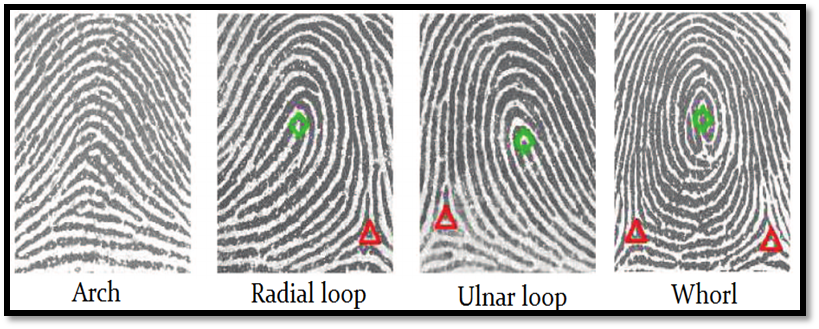
Figure (2): Main types of finger patterns
In quantitative aspects, number of triradii per individual, finger pattern intensity index, Dankmeijir‘s Arch- Whorl index, Furuhata‘s whorl-loop index and the total ridge counts (TRC ) are studied. For doing the ridge counting, the procedure given by Holt 1968 is followed, figure (3), Data on fingerprints for left and right hands in males and females are listed separately, to provide information on bilateral and sexual variation.
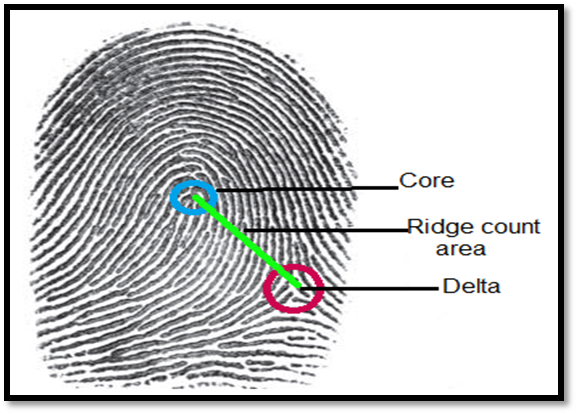
Figure (3): The procedure of total ridge counts (TRC)
The dermatoglyphic data obtained in the present study was analyzed statistically and tabulated. Basic calculations like percentage of frequencies of quantitative characters and measure of central tendency such as arithmetic mean, measures of variation such as standard deviation (S.D), standard error (S.E), and Chi-square test etc. Were done following the same procedures as described earlier. In addition, the following indices were computed in case of finger patterns, which represent the ratio of two comparable patterns expressed as percentage.
Results:
The frequency of different pattern types for males and females in the area studied. Ulnar loops were higher in females than males, in contrary to whorls which was higher in males than females.
The percentage frequencies of digital patterns obtained for all cities samples are given in Table (1). Significant differences were found between males and females in digits R1, R2, R3, R5, and L3. Finger R1 (57%) was higher in whorls type, whereas finger R3 (18.8%) was lower in whorls in both right and left hand and males and females Finger L5 was higher in ulnar loops (71.3) in right and left hand of males, whereas finger R3 and R5 had higher ulnar loops (73.7%) in right and left hand of females. In addition, finger L2 had higher arches (13.1%) in both left and right hand and males and females. Finger L3 had higher radial loops (10.3%) both left and right hand and males and females.
Table: (1) Percentages of digital pattern for all cities
| (n =544) | Female | (n =588) | Male | Total | |||||
| Sig | W | RL | UL | A | W | RL | UL | A | Digit |
| 0.000 | 45.2 | 0.7 | 51.8 | 2.2 | 57 | 0.5 | 39.2 | 3.2 | R1 |
| 0.009 | 39 | 6.1 | 44.1 | 10.8 | 44.6 | 9.7 | 36 | 9.7 | R2 |
| 0.001 | 18.8 | 1.7 | 73.7 | 5.9 | 27.8 | 1.4 | 63.1 | 7.7 | R3 |
| 0.185 | 47.1 | 1.8 | 46.7 | 4.4 | 53.4 | 1.3 | 41 | 4.3 | R4 |
| 0.017 | 19.3 | 1.7 | 73.3 | 5.7 | 26.7 | 2 | 67.6 | 3.8 | R5 |
| 0.650 | 41.5 | 2.8 | 51.5 | 4.2 | 43.2 | 2.5 | 48.7 | 5.6 | L1 |
| 0.346 | 37.5 | 10.3 | 39.2 | 13.1 | 41 | 7.5 | 38.9 | 12.5 | L2 |
| 0.037 | 22.4 | 4 | 63.4 | 10.1 | 29.2 | 4.8 | 58.4 | 7.5 | L3 |
| 0.769 | 43.4 | 3.7 | 45.8 | 7.2 | 45.2 | 3.4 | 45.7 | 5.7 | L4 |
| 0.293 | 20.8 | 4.4 | 68.6 | 6.2 | 20.6 | 4.3 | 71.3 | 3.8 | L5 |
| 0.012 | 33.5 | 3,7 | 55.8 | 7.0 | 38.9 | 3.7 | 51.0 | 6.4 | Total |
All cities digital ridge counts were generally higher in males than females in right than left hands especially in males Table (2). Significant differences were found between males and females in digit R1, R3, and R5. Digit R1 and L1 were the highest among all digits in both males and females and left and right hands. Total Finger ridge count was significantly (p<0.01) higher in males (138.35) than females (131.46). total ridges counts were significantly (p<0.01) higher in males than females.
Table (2) Ridge count for males and females
| (n=544) | Female | (n=558) | Male | |||
| Sig | Se | Mean | Se | Mean | Finger | |
| 0.000 | 0.541 | 23.96 | 0.597 | 26.96 | R1 | |
| 0.374 | 0.537 | 17.07 | 0.545 | 17.75 | R2 | |
| 0.046 | 0.444 | 14.89 | 0.479 | 16.2 | R3 | |
| 0.099 | 0.544 | 20.81 | 0.53 | 22.06 | R4 | |
| 0.006 | 0.379 | 14.9 | 0.38 | 16.37 | R5 | |
| 0.140 | 0.541 | 22.02 | 0.57 | 23.18 | L1 | |
| 0.626 | 0.519 | 16.04 | 0.506 | 16.4 | L2 | |
| 0.166 | 0.501 | 15.57 | 0.494 | 16.54 | L3 | |
| 0.396 | 0.559 | 14.96 | 0.519 | 20.48 | L4 | |
| 0.310 | 0.408 | 14.96 | 0.404 | 16.2 | L5 | |
| 0.010 | 1.9 | 131.46 | 1.86 | 138.35 | TCR |
Total ridge counts for males and females of each city. Total ridge counts were generally higher in males than females except in Jalu-Ojla and Al-Marj cities, where they are the same. Total ridge counts were the lowest in Jalu-Ojla and Dernah cities.
Differences between digital ridge counts in right and left hand were found for all digits, except for RC5 and LC5 Table (3). The bilateral digital ridge count correlations were found significant(p<001) and ranged between 0.651 and 0.755.
Table (3) Digital ridge counts of right and left hands
| Correlation | Significant | Mean ± SE
(1102) |
Mean ± SE
(1102) |
Digit |
| 0.724*** | 0.001 | 22.61 ± 0.39 | 25.48 ± 0.41 | RC1_LC1 |
| 0.775*** | 0.001 | 16.22 ± 0.36 | 17.41 ± 0.83 | RC2_LC2 |
| 0.750*** | 0.034 | 16.06 ± 0.35 | 15.55 ± 0.33 | RC3_LC3 |
| 0.733*** | 0.001 | 20.16 ± 0.3 | 21.44 ± 0.38 | RC4_LC4 |
| 0.651*** | 0.788 | 15.58 ± 0.87 | 15.65 ± 0.27 | RC5_LC5 |
* – (p< 0.05), **- (p< 0.01), ***- (p<0.001)
Total ridge counts for males and females of each city are shown in figure (4). Total ridge counts were generally higher in males than females except in Jalu-Ojla and Al-Marj cities, where they are the same. Total ridge counts were the lowest in Jalu-Ojla and Dernah cities.
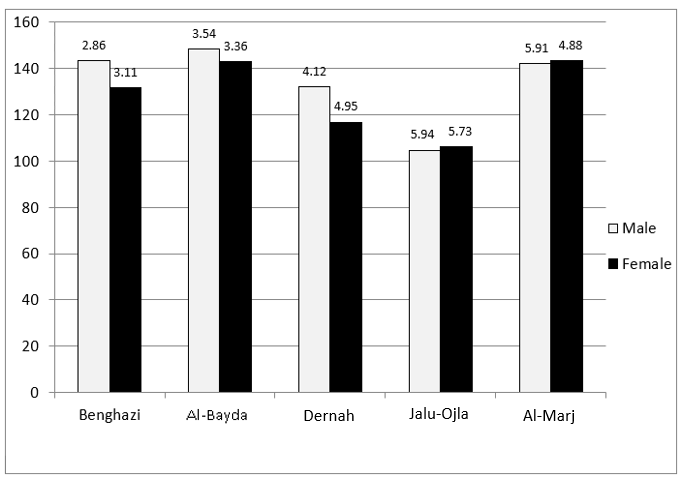
Figure (4) Total ridge counts for males and females in different cities
Ulnar loops were generally higher in all cities then whorls come second while arches least one figure (5). Jalu-Ojla characterized by highest frequency of arches and the lowest in ulnar loops.
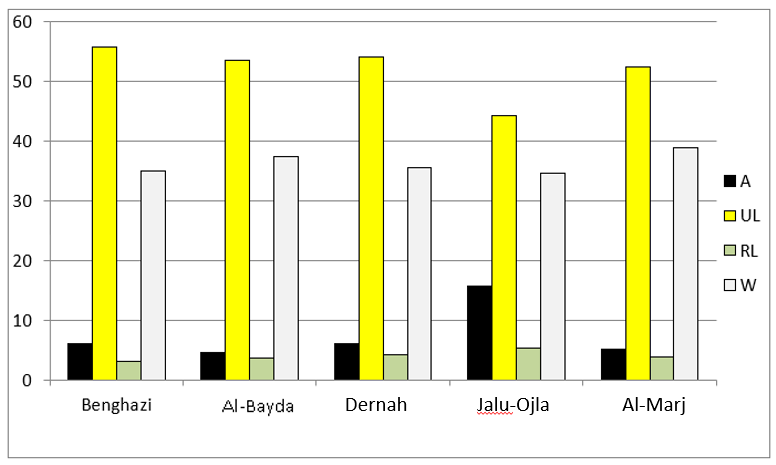
Figure (5) frequency of four digital pattern types (A: Arch, UL: Ulnar Loop, RL: Redial Loop, W: Whorl) in the different region.
Sexual differences: Ulnar loop were more frequent in male and female (51%, 55.8%) in east part of Libya, than whorl (38.9% and 33.5% respectively). In addition, arches were more frequent in male and female (6.4% and 7.0%) than radial loops (3.7%). The later frequency of Arches in this study were little higher than more estimate of previous studies except that in Al-Bayda (6.3%) (Abdalsadiq, 2004). Generally our results in agreement with those obtained in Morocco (Gessain, 1957), Algeria (Chamla, 1961), Tunisia (Emberger & Fourmont, 1970), but not with those obtained by (Elatrash, Abdelazeem, Ghaleb, & Makhloph, 2018) in Egypt where the Arches were significantly difference between Libyans and Egyptians people (males and females).
The differences in digital pattern for each finger ware found between male and female as well as in the right and left hand for all the cities in this study. Many researchers reported that there were significant differences between the genders male and female in digital pattern (E Gualdi-Russo, Facchini, Brasili-Gualandi, Gruppioni, & Pettener, 1994; Gutiérrez, Galera, Martínez, & Alonso, 2007; P. S. Igbigbi & Msamati, 2002; Sabir et al., 2005) as well as for the bilateral pattern (Eshak, Zaher, Hasan, & Ewis, 2013; Emanuela Gualdi-Russo, Zannotti, & Cenni, 1982; Harich, Esteban, Chafik, & Moral, 2002).
The significant differences (p < 0.05) were obtained in the right-hand fingers in comparing to the left-hand fingers for all the cites in eastern part of Libya that may, because of the sexual dimorphism appear in the dermatoglyphic patterns, which can be supported by the differences in heritability and developmental variation among males and females (Meier, 1980). Otherwise, bimanual differences have been attributed to developmental instability, measured by fluctuating asymmetry of bilateral traits which in the particular case of dermatoglyphics must result from environmental assaults during early embryogenesis stages. (Cummins & Midlo, 1961).
The frequencies of digital pattern between cities showed a significant difference (p<0.05) especial for Jalu-Ojla which characterized by higher arches and lower ulnar loops compared with other sites. Al-Marj city has higher whorl frequency compared with other cities. Differences between Jalu-Ojla and the other cities are expected since the historical background of population was quite different from other cities. Oajla tribes in Ojla were from old Libyan resident Berber. In addition, Al-Mjabra tribes were colonized Jalu and they are mixture of Al-Mjabra and Al-Jowazi tribes from east part of Libya (De-Augstini, 1922). The differences might be due to consanguinity on the sub-population level inside the cities, founder effect and random drift of genes. As an example in Sardinian population found that, isolation and genetic drift are a very important as evaluative forces at the basis of micro differentiation among the Sardinian sub-populations (Floris, Franceschi, Paoli, Sanna, & Taglioli, 1998).
Also, Consanguinity level one of the factors that play important role to increase the level of homozygosity in the sub-populations inside the east of Libyan cities. Some Libyan tribes deliberately stipulate that the marriages between their individuals must be from the same tribe, and since some of these tribes commonly found in some specific cities (e.g Oajla in Ojla) that will lead to increase the homozygosity inside these cities as well as increase the differences comparing to the other cities.
In the sub-population level, the percentage of digital pattern for Benghazi Al-Bayda, Dernah, Jalu-Ojla, and Al-Marj cities showed a different frequency for pattern type of each finger, whorls (finger R1) were higher in Benghazi, Al-Bayda, Dernah, Jalu-Oajla and Al-Marj, whereas Ulnar loops (R5 and L5) were higher in Benghazi, Al-Bayda, Dernah and Jalu-Ojla but not in Al-Marj which represent a high frequent level within the fingers R3 and L3.
A different Arches pattern frequencies were found between the cities in this study, in Benghazi, Al-Bayda and Dernah have high frequency of arches within fingers L2 and R2 for both genders, whereas the fingers R3 and L2 for males and R5 for females were higher in Jalu-Ojla. Al-Marj city has a high frequency of arches pattern within the R5 and L2 fingers in males and R2 and L3 in females. All these differences in digital pattern frequencies were reported in many studies (E Gualdi-Russo et al., 1994; Harich et al., 2002).
Total ridge counts were higher in males than females and within fingers R1, R3 and R5 in the right-hand, but not in left-hand for all the study areas. Many researchers reported differences between males and female (E Gualdi-Russo et al., 1994; Sabir et al., 2005). This might be attributed to the increase of finger ridge counts in right-hand is results of increasing whorl within finger in right-hand than finger in left-hand.
In Murcia, a Spanish population, it was reported that the highest mean of ridge counts was shown by the thumb of each hand in males and females, as a result of both elevated frequency of whorls and pattern width while the lowest number of ridges corresponded to index finger in both right and left hands for males and females which can be explained by the high frequency of arches and radial loops in this finger as well as the small pattern width (Esteban & Moral, 1992).
Total ridge count has the same trends higher in male than female in Benghazi, Al-Bayda and Dernah, however. In case of Jalu-Ojla and Al-Marj female have a little higher than males. Many studies reported different total ridge counts between sub-populations in the level of cities, (Adetona, Oladapo, & Igbigbi, 2008; Gazmend, Jasna, Iibrahim, Nina, & Tatjana, 2010; E Gualdi-Russo et al., 1994). The differences might be attributed to different historical background of population in those cities because of random drift and gene flow. The highest frequency of ridge counts was recorded within R1 and R2 for all the eastern Libyan cities in this study. That could be consider as an unique feature characterized Libyan population in east part of Libya. This later result came in line with previous studies (Gazmend et al., 2010; P. Igbigbi, 2019).
Bilateral dermatoglyphic: Correlations between same fingers in right and left hands were generally high ranged between (0.65 & 0.75) and highly significant. however, these correlations are not reach to 1, which allowed to some variation between fingers in right and left hand. This result in line with previous studies obtained by (Eshak et al., 2013; Harich et al., 2002).These differences might be attributed to developmental noise.
Blomberg (2006) reported that extrinsic noise driven by fluctuations in the environment that propagate into the organism, and intrinsic noise arising from the finite numbers of entities and interactions inside cells and tissues (Blomberg, 2006).
Woods (2014) reviewed literature and stated that biological systems contain two kinds of noise, Intrinsic noise is often but not always destructive, and organisms and their cells have evolved sophisticated feedback mechanisms for dampening its effects (Woods, 2014). However, intrinsic noise also creates biological diversity that acts as a kind of simultaneous, spatially distributed plasticity, which propose to call mosaic physiology. mosaic physiology may play adaptive roles in organisms because it establishes the cellular foundations for broadening the set of phenotypes expressed by cells, tissues and organs. This kind of variation provides a set of functional phenotypes that may complement other diversity-generating mechanisms like phenotypic plasticity and phenotypic flexibility.
Hofmann et al., (2014) measured developmental noise and indicated that an increase in the standard deviation of the distribution of developmental noise of about 70 percent (Hofmann, Boine-Frankenheim, & Beams, 2014). The directional asymmetry is slightly less than one excess ridge to the left. Although the biological mechanisms for subtle directional asymmetry are poorly understood, there is evidence that stressors may act to amplify the degree of DA (Graham, Freeman, & Emlen, 1994).
References:
Abdalsadiq, N. (2004). Comparative Studies of Dermatoglyphics Traits in Benghazi and AL-Baida. (Msc), University of Benghzi.,
Adetona, M., Oladapo, O., & Igbigbi, P. (2008). Palmar and digital dermatogylyphic patterns of the three major ethnic groups in Nigeria. African Journal of Medicine Medical Sciences, 37(4), 333-337.
Ben Salah, K. S. (2001). A study on dermatoglyphics of Libyan ppopulation. (MSc), Arab Medicine University, Benghazi.
Blomberg, C. (2006). Fluctuations for good and bad: the role of noise in living systems. Physics of Life Reviews, 3(3), 133-161.
Chamla, M. C. (1961). Les empreintes digitales de 2.336 Algériens musulmans.
Crawford, M. H., & Duggirala, R. (1992). Digital dermatoglyphic patterns of Eskimo and Amerindian populations: Relationships between geographic, dermatoglyphic, genetic, and linguistic distances. Human biology, 683-704.
Cummins, H., & Midlo, C. (1961). Finger prints, palms and soles: an introduction to dermatoglyphics (Vol. 319): Dover Publications New York.
De-Augstini, H. (1922). Inhabitant of Cerinyaca. (Ibrahim ahmad Almahdawi, Trans.). In. University of Bengazi, Libya.
Demarchi, D. A., Giordano, A. R., & Marcellino, A. J. (1997). Dermatoglyphics in Araucanian Indians from Patagonia and multivariate comparisons with other Argentinian aboriginal populations. Human biology, 227-239.
Elatrash, F. M., Abdelazeem, G. M., Ghaleb, S. S., & Makhloph, M. G. (2018). Comparison study of finger prints pattern in some egyptians and libyan people. International Journal of Medical Toxicology Legal Medicine, 21(1and2), 1-2.
Emberger, J., & Fourmont, M. (1970). Les dermatoglyphes digito-palmaires d’un groupe de Tunisiens. Journal de génétique humaine, 18, 1-19.
Eshak, G. A., Zaher, J. F., Hasan, E. I., & Ewis, A. A. E.-A. (2013). Sex identification from fingertip features in Egyptian population. Journal of Forensic Legal Medicine, 20(1), 46-50.
Esteban, E., & Moral, P. (1992). Quantitative finger dermatoglyphics in the Mediterranean region of Murcia, Spain. International Journal of Anthropology, 7(2), 17-25.
Floris, G., Franceschi, M., Paoli, G., Sanna, E., & Taglioli, L. (1998). Population structure in Sardinia on the basis of quantitative palmar dermatoglyphic traits. 13(1), 57-64.
Gazmend, T., Jasna, M., Iibrahim, B., Nina, S. N., & Tatjana, Š.-J. (2010). The Quantitative Dermatoglyphic Traits in Three Population Groups of Albanians from Kosovo. The Anthropologist, 12(4), 251-258.
Gessain, M. (1957). Les crêtes papillaires digitales de 194 marocains. Bulletins et Mémoires de la Société d’Anthropologie de Paris, 8(5), 341-353.
Graham, J. H., Freeman, D. C., & Emlen, J. M. (1994). Antisymmetry, directional asymmetry, and dynamic morphogenesis. In Developmental instability: Its origins and evolutionary implications (pp. 123-139): Springer.
Gualdi-Russo, E., Facchini, F., Brasili-Gualandi, P., Gruppioni, G., & Pettener, D. (1994). Digital and palmar dermatoglyphics and the population structure of the Upper Bologna Apennine. Annals of human biology, 21(6), 519-532.
Gualdi-Russo, E., Zannotti, M., & Cenni, S. (1982). Digital dermatoglyphics in Italians. 373-386.
Gutiérrez, E., Galera, V., Martínez, J. M., & Alonso, C. (2007). Biological variability of the minutiae in the fingerprints of a sample of the Spanish population. Forensic Science International, 172(2-3), 98-105.
Harich, N., Esteban, E., Chafik, A., & Moral, P. (2002). Dermatoglyphic characterization of Berbers from Morocco: qualitative and quantitative digital and palm data. 29(4), 442-456.
Hofmann, I., Boine-Frankenheim, O., & Beams. (2014). Grid dependent noise and entropy growth in anisotropic 3d particle-in-cell simulation of high intensity beams. Physical Review Special Topics-Accelerators, 17(12), 124201.
Holt, S. B. (1968). The genetics of dermal ridges: Thomas.
Igbigbi, P. (2019). Palmar and digital dermatoglyphic traits of sub-Saharan African subjects. African Journal of Medicine Medical Sciences, 48(3), 285-296.
Igbigbi, P. S., & Msamati, B. C. (2002). Palmar and digital dermatoglyphics of indigenous black Zimbabweans. 8(11), CR757-CR761.
Karmakar, B., Yakovenko, K., & Kobyliansky, E. (2002). Dermatoglyphic sexual dimorphism: Finger and palmar qualitative characteristics in five endogamous populations of West Bengal, India. Anthropologischer Anzeiger, 273-292.
Mavalwala, J. (1977). Dermatoglyphics: an international bibliography: Mouton de Gruyter.
Meier, R. J. (1980). Anthropological dermatoglyphics: a review. American journal of physical anthropology, 23(S1), 147-178.
Milicić, J. (2002). Latent structure of quantitative dermatoglyphic traits of middle Dalmatia (Croatia). Collegium antropologicum, 26, 39-45.
Naffah, J. (1974). Dermatoglyphics and flexion creases in the Lebanese population. American journal of physical anthropology, 41(3), 391-409.
Penrose, L. (1968). Medical significance of finger-prints and related phenomena. British medical journal, 2(5601), 321.
Plato, C. C. (1970). Polymorphism of the C line of palmar dermatoglyphics with a new classification of the C line terminations. American journal of physical anthropology, 33(3), 413-419.
Plato, C. C., Brown, P., & Gajdusek, D. C. (1972). Dermatoglyphics of the Micronesians from the Outer Islands of Yap. Zeitschrift für Morphologie und Anthropologie(H. 1), 29-44.
Sabir, B., Cherkaoui, M., Baali, A., Lemaire, O., Dugoujon, J., & Boëtsch, G. (2005). Characterisation of the digital dermatoglyphic in a berber population of the high Atlas (Marrakesh, Morrocco). 20(3), 277-289.
Siváková, D., & Pospíšil, M. (2001). Dermatoglyphic analysis of Habans (Hutterites) from Slovakia. 355-363.
Woods, H. A. (2014). Mosaic physiology from developmental noise: within-organism physiological diversity as an alternative to phenotypic plasticity and phenotypic flexibility. Journal of Experimental Biology, 217(1), 35-45.
Worldometer. (2020). Libya Population. Retrieved from https://www.worldometers.info/world-population/libya-population/
